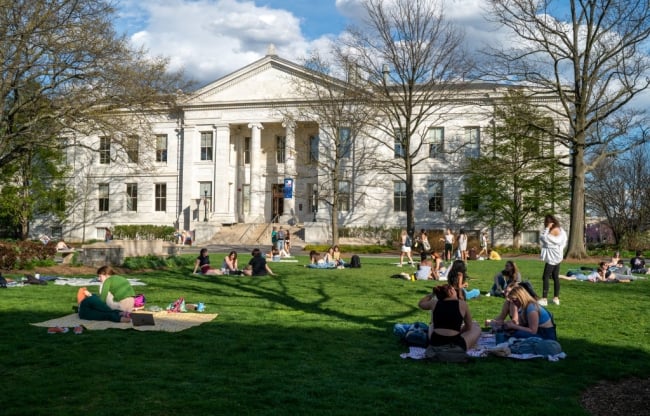You have /5 articles left.
Sign up for a free account or log in.

American University leadership created new support resources for students feeling heightened anxiety after changes to the federal government.
Robert Nickelsberg/Getty Images North America
Over the past 60 days, President Donald Trump and his administration have made sweeping changes to the higher education landscape, including mass layoffs at the Department of Education, an executive order that will dismantle key functionality of the department, grant freezes and the deportations of international students.
The changes have resulted in increased anxieties for some students as they worry about federal financial aid, future employment opportunities or immigration, said Ashlie Prioleau, assistant vice president for student success, retention and thriving at American University.
“Some of our students have lost jobs or internships that have affected them,” said Dayne Hutchinson, assistant vice president for student engagement and success. “Some of their parents have lost their jobs in the federal government, and that obviously has impact on students. I think there’s just significant uncertainty in a space that is usually very certain for our students.”
In response, officials have established support resources to attempt to soothe student worries and create community.
How it works: The Division of Student Affairs created a webpage, Building Community and Finding Support, which consolidates all student-facing programs to address feelings of uncertainty.
The site aggregates events that address advocacy and engagement or celebrate community and togetherness. The page also links to relevant departments, including the Center for Leadership and Community Engagement and the Kay Spiritual Life Center, that could support dimensions of student well-being.
“Part of that is having difficult conversations: How do you take care of yourself in times of crisis and conflict?” Hutchinson said.
The initiative is supported by a variety of campus community members. Alumni, for their part, are sharing job openings for unemployed students or those who will be displaced upon graduation, and the AU Market Pantry is serving those with basic needs insecurity.
Meeting Students’ Needs
The University of Hawai‘i Foundation created a new fund for graduate researchers who lost funding as a result of federal freezes to keep them enrolled and help them complete their programs.
“It’s really an all-hands-on-deck effort across the university to collect information [and] put it in one place,” Hutchinson said.
Another community-based intervention is student support circles, which are informal connection spaces that help students connect to peers and staff to discuss topics that they care about. The circles were initially created last fall to help students navigate higher education and create peer connections but have since grown to include a campuswide focus on wellness.
“Student support circles are intended to fill a gap where they can feel like they can vent if they need to,” Prioleau said. The circles are open to all community members, and participants can receive free food for attending. The circles also help provide space for growth and thriving, considering positive change and future opportunities.
The impact: Since launching, the support circles have seen consistent numbers of students showing up to the sessions, which suggests to Prioleau that learners see the value of the work.
For the webpage Building Community and Finding Support, staff are tracking student participation and feedback to enhance their offerings and make engagement more accessible, but so far both projects have received positive responses.
Both projects are outside the scope of Prioleau and Hutchinson’s typical work. “It takes heart,” as Prioleau puts it, and speaks to the need to be responsive to campus climate.
“Our offices are always open for students who want to come in and talk to us about what’s happening in their own lives individually,” Hutchinson said.
In the same way, AU leaders look to support staff and ensure that they’re receiving care as they help address the challenges students are facing.
Seeking stories from campus leaders, faculty members and staff for our Student Success focus. Share here.








